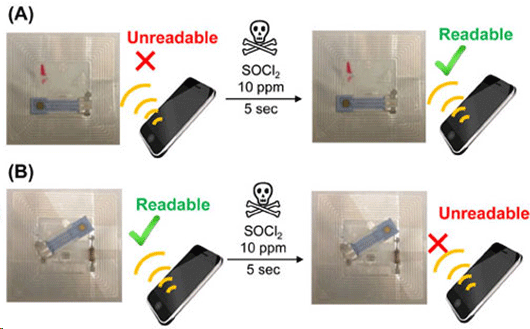|
NOVIDADES
A joint research group including senior researcher Shinsuke Ishihara at the Frontier Molecules Group, International Center for Materials Nanoarchitectonics (MANA), National Institute for Materials Science (NIMS), and Professor Timothy M. Swager, at the Massachusetts Institute of Technology (MIT), developed a chemical sensing material whose electrical conductivity dramatically increases when exposed to toxic gases (Journal of the American Chemical Society, "Ultratrace Detection of Toxic Chemicals: Triggered Disassembly of Supramolecular Nanotube Wrappers"). In addition, the group integrated the sensing material into the electronic circuit in a near-field communication (NFC) tag, which is embedded in smart cards like those used to get through train ticket gates. Then, it was demonstrated that this technology made it possible for smartphones to quickly (in 5 sec) detect toxic gases at a low concentration (10 ppm).  Toxic gas sensor integrated with a near field communication (NFC) tag linked to a smartphone. People in today’s society are subject to risks of being exposed to toxic gases deriving from natural sources (e.g., volcanic gases), leak accidents or potential acts of terrorism. Means to easily and quickly detect toxic gases are vital in terms of minimizing their harmful effect. The currently available toxic gas sensors are expensive, bulky, heavy and difficult to operate, and it is not practical to set them at many public locations (e.g., subways) or for people to carry them around. The joint research group developed a chemical sensing material consisting of a group of carbon nanotubes (CNTs) individually wrapped with supramolecular polymers—clusters of monomers held together through weak interactions. The material’s electrical conductivity increases up to 3,000 times when it is exposed to electrophilic toxic gases. CNTs alone are highly conductive materials, but when they are wrapped with supramolecular polymers, which serve as insulators, they become poor conductors. The supramolecular polymers were designed so that weakly bound sites in the molecules are dissociated when these sites are exposed to toxic gases, causing the wrapping molecules to disassemble. As a result, the original high conductive state of CNTs is restored. The extent of change in conductivity is directly proportional to the concentration of and the duration of exposure to a toxic gas, and the conductivity change can be easily measured by a commercially available resistance meter. We created a toxic gas sensor whose measurement can be read on smartphones by integrating the chemical sensing material into the electronic circuit present in a commercially available NFC tag. Users can readily determine the presence/absence of toxic gas by holding an NFC-compatible smartphone over a sensor-embedded NFC tag while making sure that communication between the two devices is intact. The sensor is disposable, and 1 g of the chemical sensing material makes 4 million sensors. So, it is feasible to mass-produce the sensor at low cost. In future studies, we plan to develop chemical sensors capable of detecting various types of toxic chemical substances more sensitively, quickly and effortlessly by making modifications to the structure of the supramolecular polymer. We will also develop a system that contributes to making society safer by selecting the type of wireless communication technology (in terms of communication distance, power consumption, etc.) compatible with the application of chemical sensors and considering the integration of chemical sensors with the internet cloud technology. National Institute for Materials Science. Posted: Aug 24, 2016. |
|||||||||||||||||||||||||